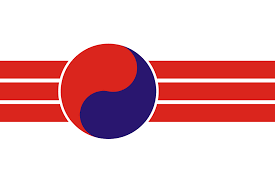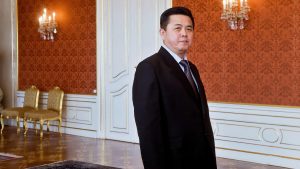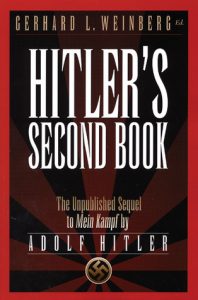No, we are not talking about the Democratic Peoples Republic of Korea, or as the cool kids call it North Korea, but of the first kind of socialist state on the Korean Peninsula, and sadly the last thing vaguely resembling a unified Korea (aside from cheerleaders)
To read about the North Korean cheerleaders click here.
Pretext to the People’s Republic of Korea
August 15th is celebrated in different ways across the world, in the UK we call it VJ day, as in victory against Japan, whilst in Korea it is known as liberation day, as in liberation from the colonial rule of Japan, which they had been under for almost 50 bitter years. During this time there were numerous anti-Japanese organizations, both communist and not, but largely Korea was a functioning and to a large extent integrated part of the Japanese Empire.
To read more about the Down-with-Imperialism-Union (DIU) click here.
Who liberated Korea?
There are lots of different opinions on this, of course in the DPRK they are firmly of the belief that it was Kim Il-Sung with minor help from the Soviets.
Another view though might be that Korea was not liberated as such, and it was more a case of the atomic bombs that got dropped on Japan meant that the Japanese surrendered and decided to go home.
The power vacuum in Imperial Korea
Again another misconception about the end of Japanese colonial rule in Korea was that the Americans and the Russians rocked straight up and split the country into two, but this is not exactly the case. As with other countries under Japanese rule, such as the Vietnam which declared independence, there immediately existed a power vacuum. As with other nations the Japanese needed a civilian authority, or local government from whom they could negotiate their hasty return to the motherland. The Imperial Japanese government duly requested that a civilian government be formed in Korea from whom they could negotiate their surrender and indeed safe exit from the country. This was to lead to the Peoples Republic of Korea.
The Committee for the Preparation of Korean Independence
Lyuh Moon-Hyung who had been a leading member of the catchily titled Committee for the Preparation of Korean Independence (CPKI) was asked to form a government by the Japanese, which he duly did.
Peoples committees were organized throughout the county to help transition to independence and on 28th August 1945 (CPKI) announced that it would be the new government of the Korean peninsula. Korean people running Korea, sounds great right?
The Peoples Republic of Korea
On the 12th September the CPKI duly announced the formation of the Peoples Republic of Korea, unbeknown at the time, to be the last unified Korean state.
Security and administrative rights were transferred to Lyuh, from the Japanese, with him suggesting the following conditions. At the time (before the US and Soviets arrived) the Japanese had continued killing Koreans.
- Immediate release of political prisoners and economic prisoners across the country.
- Secure food for 3 months in August, September and October.
- Don’t interfere with political activities.
- Don’t interfere with the education of students and youth.
- Don’t interfere with the mobilization of workers and peasants into workers’ councils.
The interesting part here, or at least the socialist part here was the fact that areas were being run and managed by workers and peasant councils, or as they referred to them in the USSR Soviets.
They also announced the following program
Program
- We intend to build a completely independent country.
- We are committed to establishing a democratic regime that can fulfill the basic political, economic and social needs of the entire nation.
- We will maintain national order independently and secure public life in the temporary transition period.
Was the Peoples Republic of Korea communist?
It is hard to say what it was as it lasted so briefly, but it was certainly socialistic in nature in that it wanted to initiate land redistribution and introduce something as crazy as an 8 hour day, something neither Korea has today. In the end nobody knows, but it contained a much broader coalition than occurred when the country was split into North and South.
The end of the Peoples Republic of Korea
The Soviet Union and the Americans entered the Korean peninsula towards the end of August, having already split the country along the 38th parallel and it was from both sides of the border that the death knell was delivered to the Peoples Republic of Korea.
In the north of Korea the Soviet Union saw great opportunities with the Peoples Committees and worked with them on government formation. It is alleged that one of the main leaders Cho Man-Sik was their first choice to be leader of the DPRK. Alas after publiclally declaring he did not support the trusteeship of the Soviet Union he was placed under house arrest, but later returned as an anti-communist rival to Kim Il-Sung, but eventually died in the early days of the Korean War.
The Peoples Republic of Korea in the South
The southern portion of the Korean peninsula was to fall under the control of the ardently capitalist Americans, so there was to be no messing about with leftist Workers Councils and Peoples Committees.
On December 12th the Americans outlawed the Peoples Republic of Korea, stating “one of our missions was to break down this Communist government”, and southern Korea came under the direct leadership of the Americans.
On July 19, 1947, Lyuh Woon-hyung the father of the Peoples Republic was assassinated by a right-wing Korean.
Many elements of the Peoples Republic were to remain active up until the Korean War, particularly on Jeju island, which led to the Jeju uprising and massacre of 1948-49, in some ways a precursor to the Korean War.
What would have happened if the Peoples Republic of Korea had survived?
Famous journalist of the time Edgar Snow stated the following;
“The United States landed in Korea without any preparation. However, there was already a founding committee in Korea and soon after there was political preparation. If the Americans had saved the National Preparatory Committee, the construction of Korea would have been faster and more beneficial”
Had the Americans and Soviets not rocked up it is more than likely that a socialist light type of government would have formed, not aligned with the Soviet Union, perhaps along the Yugoslavia model. It is fair to say that due to its broad appeal it would have unlikely gone down a Stalinist route.
And regardless of government type, or who they aligned with it would have meant a unified Korea, something both sides of the peninsula still dream of today.


